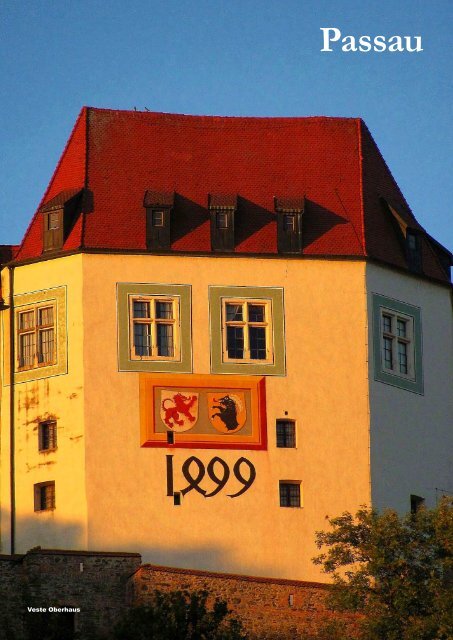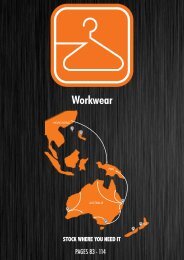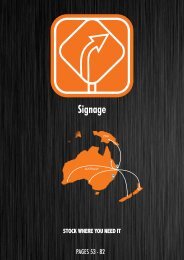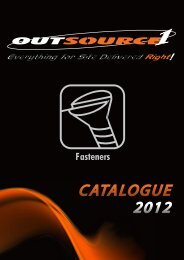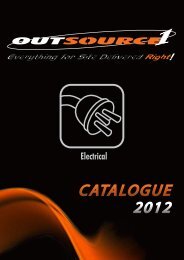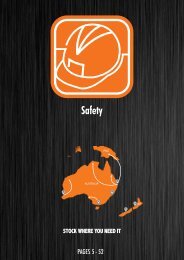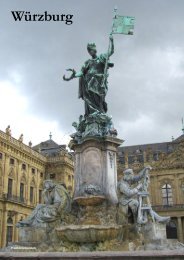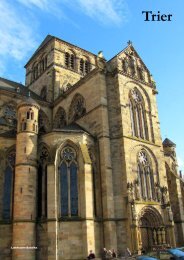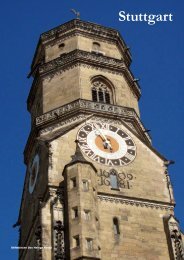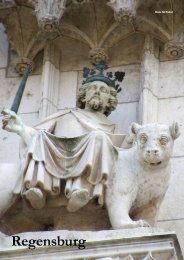Raven Guides: Germany - Passau
Create successful ePaper yourself
Turn your PDF publications into a flip-book with our unique Google optimized e-Paper software.
Veste Oberhaus<br />
<strong>Passau</strong>
<strong>Passau</strong><br />
The small city on the Austrian<br />
border is where the rivers<br />
Danube, Inn and Ilz meet at one of<br />
<strong>Germany</strong>’s legendary locations.<br />
The rest is history.<br />
Like the rivers, German-Austrian, Italian and<br />
even some Czech influences meet in <strong>Passau</strong>. An<br />
ancient regional salt trade supplied Bohemia<br />
as well as Bavaria. Batavis or Passavium,<br />
early forms of the city name, referred to the<br />
barbarian Batavian troops stationed here in<br />
the first of three forts built by the Romans.<br />
St Severin established a monastery in the 5th<br />
century and in the 8th century St Boniface<br />
founded what became the largest diocese of<br />
the Holy Roman empire, stretching along the<br />
Danube/Donau into Hungary. Its reach – and<br />
that of its bishops – into central Europe was<br />
thus extensive. Relations with Italy via Austria<br />
were renewed long after the Roman collapse.<br />
The city plays a role in the 12th or 13th<br />
century verse epic Das Nibelungenlied, a<br />
version of the ancient Nibelung tale probably<br />
compiled for the <strong>Passau</strong> bishop Wolfger. Also<br />
acquiring legendary status were swords forged<br />
locally and stamped with the <strong>Passau</strong> wolf. But<br />
its position at the river junction made the city<br />
an important distribution port in the salt trade<br />
and delivered much of its wealth.<br />
<strong>Passau</strong> became a centre for theological<br />
studies in the 17th century and much of its<br />
Baroque splendour comes from reconstruction<br />
work after the ravages of a 1662 town fire.<br />
The 2013 flood of more than 12m in a city<br />
used to flooding ravaged lower-lying parts of<br />
the city area, where residents, businesses and<br />
institutions were still carrying out remedial<br />
work months later. Only floods in 1501 are<br />
known to have been higher.<br />
Altstadt<br />
The remodelled city centre has not overshadowed<br />
the charm of the old town, which<br />
near the confluence at Dreiflüsse-Eck narrows<br />
into a network of archways, stairways and<br />
cobbled lanes. Baroque is the dominant style<br />
there and along the walled promenade on<br />
the Inn’s north bank. The narrow Höllgasse<br />
starts at the Untere Donaulände boat landings<br />
and runs parallel with the Danube through to<br />
Rathausplatz with its galleries, boutiques and<br />
gift shops.<br />
The favourite evening stroll is along the<br />
Innkai to the point of the river junction, past<br />
the 15th century tower Schaiblingsturm, which<br />
marks the medieval salt harbour. The Jesuit<br />
St-Michaels-Kirche (or Studienkirche) and the<br />
adjacent former Jesuit college are above the<br />
bank on Schwabgasse. The abbey church of<br />
Kloster Niedernburg on Jesuitengasse has the<br />
grave of the blessed abbess Gisela, once queen<br />
of the saint Stephen I of Hungary.<br />
Innstadt<br />
On the Inn’s south bank are several attractions<br />
in an ideal area for evening walking. The<br />
oldest are the footings of the Roman fort on<br />
Lederergasse (see Museums) and remnants<br />
of medieval wall along Jahnstraße, where<br />
gateways reveal a second wall line with towers.<br />
The late medieval gate Severintor is nearby on<br />
Am Severintor and the Severinkirche at the<br />
south end of the Fünferlsteg footbridge marks<br />
the site of St Severin’s 5th century basilica.<br />
The pilgrimage church Mariahilfkirche and its<br />
monastery are above Kapuzinerplatz at the top<br />
of the Mariahilfstiege steps.<br />
Information<br />
The main office of <strong>Passau</strong> Tourismus and<br />
accommodation service is centrally located at<br />
Rathausplatz 3 by the town hall, although an<br />
office is located not far from Hauptbahnhof<br />
at Bahnhofstraße 28. At the website www.<br />
tourismus.passau.de the English tab is at<br />
the bottom left. Bücher Pustet (M-Sa 9-20)<br />
at Nibelungenplatz 1 has an excellent map<br />
selection but its guidebook range is all in<br />
German. Thalia Bücher (M-Sa 9.30-20) is<br />
on the upper level at the west end of the<br />
Stadtgalerie complex.<br />
The book <strong>Passau</strong> City Guide is available<br />
at €5.80.<br />
RAVEN QUICK GUIDE<br />
Tourist information & accommodation service: Rathausplatz 3 (tel 0851-955980,<br />
email tourist-info@passau.de, Apr-Sep M-F 8.30-18, Sa-Su 9-16, Oct-Easter M-Th 8.30-17,<br />
F 8.30-16, Sa-Su 10-15); Bahnhofstraße 28 (M-F 9-12, 12.30-17, Sa-Su 10.30-15.30).<br />
Money: VR-Bank, Ludwigsplatz 1 (M-W & F 8.30-16.15, Th 8.30-17); Sparkasse,<br />
Ludwigstraße 8 (M-W 8.30-16.30, Th 8.30-18, F 8.30-17); Commerzbank, Bahnhofstraße 22<br />
(M-W & F 9-13, 14-16, Th 9-13, 14-19).<br />
Lockers: Hauptbahnhof, platform 1 (€4/2 per day).<br />
Transit information: VBP, Zentraler Omnibus Bahnhof, Dr-Hans-Kapfinger-Straße (tel<br />
0851-560186, M-Th 8-11.45, 12.30-16, F 8-14).<br />
Post: Nibelungen Center, Nikolastraße 2 (M-F 8-18, Sa 8-14).<br />
Internet: Netcafe, Nibelungen Center, Nikolastraße 2 (M-Sa 9-21, Su 12-17);<br />
Bahnhofsrestaurant, Hauptbahnhof (M-Su 9-21).<br />
Police: tel 110; Nibelungstraße 17 (tel 0851-95110).<br />
Pharmacy: Bahnhof-Apotheke-<strong>Passau</strong>, Bahnhofstraße 17 (M-F 8-18, Sa 9-18);<br />
Hofapotheke zum Schwarzen Adler, Residenzplatz 12 (M-F 8-18, Sa 8-12.30);<br />
Salvator-Apotheke, Freyunger Straße 2 (M-F 8-18, Sa 8-12); Engel-Apotheke,<br />
Bahnhofstraße 10 (M-F 8-18.15, Sa 9-16).<br />
Ambulance: tel 112.<br />
The Altstadt with the Danube in the foreground.<br />
Hospital: Klinikum <strong>Passau</strong>, Innstraße 76 (tel 0851-53000 or 19222).<br />
Transport<br />
Fast trains arrive either from Regensburg<br />
(several times daily, just over one hour) or<br />
from Linz and Vienna/Wien. Passengers to<br />
and from Regensburg can pick up services<br />
to or from Munich or Plattling, connecting<br />
through Agilis trains running Regensburg-<br />
Plattling. The Deutsche Bahn Reisezentrum<br />
(M 6-17.30, Tu-F 6.30-17.30, Sa 7-17, Su<br />
9-16.30) at the Hauptbahnhof can help with<br />
connections information and ticket machines<br />
are available when the office is closed.<br />
The Ilztalbahn rail service (using RBO<br />
bus connections) offers ways into the national<br />
park areas of the Bavarian forest (change at<br />
Freyung) and to České Budějovice/Budweis<br />
and Český Krumlov/Krumau in the Czech<br />
Republic (change at Waldkirchen for buses to<br />
join Czech trains at the border).<br />
Berlin Linien Bus runs to <strong>Passau</strong> from<br />
Berlin via Leipzig, Hof, Regensburg and<br />
Deggendorf and on to Bad Füssing (W &<br />
Sa) and return (Th & Su). The Zentraler<br />
© 2014 RAVEN TRAVEL GUIDES GERMANY<br />
RAVEN TRAVEL GUIDES GERMANY - <strong>Passau</strong> 1
The late Baroque and Neoclassical bishops’<br />
residence Neue Residenz at Residenzplatz has<br />
an ornate staircase with stucco decoration putting<br />
it among <strong>Germany</strong>’s finest (along with a ceiling<br />
fresco) usually accessible through the west door.<br />
The adjacent cathedral treasury can be reached<br />
through the cathedral. Outside on Residenzplatz<br />
is the Wittelsbacher Brunn, after the Baroque<br />
style but actually early 20th century. The<br />
Neoclassical Fürstbischöfliche Opernhaus<br />
building at the west end now houses the<br />
Stadttheater.<br />
The Rathaus goes back to at least the 14th century,<br />
although the present tower is Neogothic. The vaulted great<br />
assembly hall Großer Rathaussaal and small hall were<br />
stuccoed by Carlone in the 17th century after the great fire.<br />
In the 19th century local artist Ferdinand Wagner painted<br />
the ceilings with events from local history and<br />
Nibelung motifs when the other Wagner was in high vogue.<br />
The Rathausplatz facade with the Danube’s historical flood<br />
markers indicates the many deluges the city has survived.<br />
Großer Rathaussaal (late March-Oct M-Su 10-16, late<br />
Nov-early Jan M-Su 10-16, €2/1.50) is also part of the city<br />
tour but it or the smaller hall are often closed for functions.<br />
The tower glockenspiel sounds daily at 10.30, 14.00 and<br />
19.25 with an extra Saturday carillion at 15.30.<br />
The Dom St Stephan at Domplatz is a Gothic cathedral<br />
transformed after a 17th century fire to Italian Baroque<br />
on a grand scale by the innovative plans of Prague<br />
resident Carlo Lurago and the Italian architect Paolo<br />
d’Aglio. The opulent stucco work is by Giovanni<br />
Battista Carlone and frescoes by Carpoforo Tencalla<br />
feature the stoning of the saint. It houses one of the<br />
world’s great church organs of almost 18,000 pipes.<br />
Half-hour organ concerts (May-Oct or Christmas-New<br />
Year’s Eve, M-Sa 12-12.30, holidays closed, €4/2<br />
children under 10 free) are a highlight but connoisseurs<br />
might prefer the one-hour evening performances (May-<br />
Oct Th 19.30-20.30, €8/5).<br />
Kloster Niedernburg’s Klosterkirche zum Heiligen<br />
Kreuz in Jesuitengasse is the resting place of the blessed<br />
Gisela, queen of St Stephen and daughter of the Bavarian<br />
duke Heinrich II. The largely 12th century Romanesque<br />
church is on the site of a Carolingian predecessor. Gisela<br />
entered the convent after her husband’s death and was<br />
abbess when she died in the 1060s. Most of her remains<br />
(bones of the couple were reunited in Hungary in 1996) lie<br />
on the south side of the church, now a pilgrimage site. The<br />
Benedictine foundation was the centre of the <strong>Passau</strong><br />
bishops when they were styled prince-bishops early in the<br />
13th century and it is speculated that the Niebelungenlied<br />
poet had a special relationship with it. It was later taken<br />
over by the sisterhood founded by English nun Mary Ward.<br />
Veste Oberhaus, the Gothic castle high above the Danube,<br />
overlooking the old town, is the former fortress of the<br />
<strong>Passau</strong> bishops and later a military prison. Apart from the<br />
spectacular view and youth hostel there is the excellent<br />
Oberhausmuseum <strong>Passau</strong> (see Museums below), pulling<br />
together the themes of the city’s complex history. Walking<br />
up (the path Ludwigsteig closes at 17.00 daily) involves a<br />
little effort and many will find the half-hourly shuttle bus<br />
from Rathausplatz (mid Apr-early Nov M-F 10-17, Sa-Su<br />
10-18, €1.70/€1.20, families €5.50) worth the fare and opt<br />
for the stroll down. At times the path becomes hazardous<br />
during winter weather. Veste Niederhaus below, though<br />
connected by battlements, is closed to the public and the<br />
best view of it is from a river ferry or Dreiflüsse Eck.<br />
Omnibusbahnhof on Dr-Hans-Kapfinger-<br />
Straße at Nibelungplatz handles regional and<br />
long-distance buses.<br />
Danube ferries (see Cruises) are the<br />
leisurely alternatives in both directions.<br />
Bicycle riders find in <strong>Passau</strong> the hub of<br />
several bicycle paths. The German portion of<br />
the Donauradweg from Donaueschingen joins<br />
the Austrian portion at the border, continuing<br />
via Linz to Vienna. The Inntalradweg follows<br />
the Inn valley to Innsbruck in Austria,<br />
continuing to the pass at Maloja beyond St<br />
Moritz in Switzerland.<br />
Other routes lead to Salzburg, Neumarkt in<br />
der Oberpfalz and Bad Gögging on the Danube<br />
between Regensburg and Ingolstadt (called the<br />
Via Danubia or Römerradweg).<br />
City transit: Local buses also converge on<br />
the ZOB. The VBP local transit information<br />
office there (see Quick Guide) is open to 18.00<br />
on the first two and last two working days of<br />
each month.<br />
<strong>Passau</strong> has extensive pedestrian zones and<br />
the only buses likely to appeal (unless crossing<br />
the Inn) are the castle shuttle and Citybus. The<br />
VBP bus network, including the shuttle, is<br />
covered by <strong>Passau</strong>Card (see below) or Bayern-<br />
Ticket. Single-trip tickets (€1.70/1.20) last 90<br />
minutes and allow changes of bus (except for<br />
the castle shuttle) but strip tickets for eight<br />
journeys (€9/5.50, to be validated on board)<br />
are considerably cheaper. Tickets can be<br />
bought from bus drivers.<br />
The Citybus (M-Sa 7.30-18.30, single trip<br />
€0.90) shuttles between the Hauptbahnhof<br />
and Römerplatz at the end of Prinzregent-<br />
Leopold-Brücke via Rathausplatz and the<br />
ZOB. Motorists with a short-term parking pass<br />
at the Hauptbahnhof Parkhaus can use this as<br />
a Citybus ticket.<br />
Bus route numbers preceded by a K are<br />
for smaller vehicles. A contracted evening bus<br />
service (M-Su 20.30-23.30) runs nine routes<br />
from the ZOB to connect outer areas.<br />
There are several bike hire options.<br />
Fahrrad-Laden <strong>Passau</strong> (tel 0851-72226, Apr-<br />
Sep M-F 8-18, Sa 8-14, Oct-Mar M-F 10-18,<br />
Sa 10-14) at Roßtränke 12 has bicycles at €13<br />
per day, €11 per day for three days and €10 per<br />
day for a week and can arrange access to public<br />
bike lockers for travellers. Bikehaus (tel 0151-<br />
12834224, Mar-mid Oct M-Su 9-12.30, 15-18)<br />
at the end of platform 1 at the Hauptbahnhof<br />
has similar rates and is part of the Rent A<br />
Bike network, offering a pick-up and drop-off<br />
scheme along the Danube to Vienna.<br />
<strong>Passau</strong>Card<br />
The card allows free entry to <strong>Passau</strong> museums,<br />
free city tours and three rivers cruises (see<br />
Cruises), a return trip on the castle shuttle<br />
bus (and a coffee at the cafe) and free bus<br />
travel. Discounts or specials on shopping and<br />
attractions in the <strong>Passau</strong> region are included.<br />
<strong>Passau</strong>Cards for one, two or three days<br />
(€15/12, €22/15 or €27.50/19) or up to<br />
three weeks (€59/41) are available at tourist<br />
information offices and many accommodation<br />
houses.<br />
Tours<br />
English city sightseeing tours are by<br />
arrangement only (tel 0851-955980, email<br />
stadtfuehrung@passau.de). But electronic<br />
guides in English can be hired (€7.50 for<br />
three hours, €10 overnight for return the next<br />
<strong>Passau</strong> 2 - RAVEN TRAVEL GUIDES GERMANY
morning) from one of the tourist offices.<br />
Cruises<br />
Donauschiffahrt Wurm+Köck (Höllgasse 26,<br />
tel 0851-929292, email info@donauschiffahrt<br />
.de, www.donauschiffahrt.de) runs 45-minute<br />
Dreiflüsse Stadtrundfahrt cruises taking in<br />
the three rivers and giving a picture of the<br />
city from the water. They depart half-hourly<br />
opposite Rathausplatz (early Mar-early Nov<br />
M-Su 10-17, €7.80/3.90). Two-hour dance<br />
or summer buffet cruises and festival period<br />
options are also available. Services to and<br />
from Deggendorf vary by season.<br />
Other high-season cruises into Austria<br />
land at Engelhartszell (M-Su, €14.50/7.25) or<br />
Linz (Tu-Su, €23/11.50). The Linz cruise has<br />
a €26/13 day return fare with a €29/14.50 bus<br />
or train return option and links with services<br />
to Vienna.<br />
The black waters of the Ilz, front, and the green-grey Inn,<br />
rear, merge with the sometimes-blue Danube.<br />
In the Innstadt remains of <strong>Passau</strong>’s medieval walls<br />
line the Lederergasse-Jahnstraße precinct. Cross<br />
the Fünferlsteg footbridge from the city centre and<br />
on the right is the last Romanesque-Gothic church<br />
of St Severin (Mar-Oct 7-18, Apr & Sep 7-19,<br />
May-Aug 7-20, Nov-Feb 7-17). The saint was the<br />
5th century founder of a nearby monastery. It is<br />
now a cemetery church and many late-medieval<br />
gravestones are set in the walls. Walk through the<br />
stone gate Severintor into Jahnstraße and the line<br />
of walls and towers stretches east. On<br />
Lindental a substantial tower, now incorporated<br />
into a residence, can be viewed. Take buses 3 or 4<br />
to Jahnstraße.<br />
On the hill above the main Inn bridge is the monastery and<br />
pilgrimage church of Mariahilf with pilgrim steps leading<br />
up from Schmiedegasse at Kapuzinerplatz. The church<br />
became a pilgrimage centre after the emperor Leopold I<br />
prayed there with success for victory over the Ottomans<br />
in 1683. The passage of more than 300 steps leads to the<br />
monastery courtyard and its cross stations are from the 19th<br />
century but 17th century monastery buildings remain. At the<br />
altar a copy of Lucas Cranach the elder’s Mary with Christ<br />
child (c1540) stands in place of the original that was once<br />
in the church. The passage is used by pilgrims and a less<br />
intrusive alternative route is the second set of steps from<br />
Innstadtkellerweg (the first is closed). Take bus K1 (hourly)<br />
to Mozartstraße or buses 3 or 4 to Jahnstraße and climb.<br />
The Roman fortress of Boiotro was the<br />
frontier of the province of Noricum in<br />
the 2nd and 3rd centuries. The<br />
Romans, who had themselves displaced<br />
the local Celtic settlement Boiodurum,<br />
were attacked by Germanic tribes and<br />
forced to build again nearby. Römer<br />
Museum Boiotro stands amid the partly<br />
reconstructed remains of the site as a<br />
collection of Roman finds and history<br />
(see Museums below). Two 3D scopes<br />
in the garden reconstruct how the fort<br />
would have looked in antiquity. Take<br />
buses 3 or 4 to Jahnstraße.<br />
Views<br />
The finest vantage points are above the<br />
Danube’s north bank along the path<br />
Ludwigsteig below Veste Oberhaus or from<br />
the fortress itself. There the striking contrasts<br />
between the blue of the Danube, the greygreen<br />
Inn and the darker Ilz are best studied.<br />
The small terrace beside Mariahilfkirche<br />
offers another perspective on the old town.<br />
For a more inclusive view of the rivers and<br />
city by arrangement, consider balloon flights<br />
(€160/95) with Dreiflüsse-Ballooning <strong>Passau</strong>,<br />
Malerweg 2A (tel 0171-4728416, email info@<br />
dreifluesseballooning.de, www.dreifluesseballooning.de).<br />
MB Bayernhimmel Ballonfahrt,<br />
Ludwigsplatz 4, tel 08513-4600,<br />
bayernhimmel.de flies from Veste Oberhaus<br />
(€180/160).<br />
Parks & gardens<br />
The most peaceful point in the city is usually<br />
the Dreiflüsse Eck, where a small greened<br />
spot allows contemplation of the place where<br />
the rivers merge. The lack of other such areas<br />
means there is sometimes activity, such as<br />
children’s amusements, during summer.<br />
Taking in the view of the whole city from<br />
almost anywhere on the wooded Ludwigsteig<br />
just below Veste Oberhaus is also a restful<br />
experience.<br />
Food<br />
The restaurant Am Paulusbogen (tel 0851-<br />
931060, M-Su 7-23) under the church vaults at<br />
the east end of Rindermarkt includes grills and<br />
a list of Balkan specialities under €20 and can<br />
boast a terrace overlooking the Danube with a<br />
view of the fortress above.<br />
The unassuming Restaurant <strong>Passau</strong> at<br />
Schrottgasse 10 offers a Greek menu as well as<br />
fish and salads with most courses in the €8-18<br />
range. Vito’s Gustoria at Grabengasse 21 is<br />
a small cafe restaurant with variety including<br />
pasta, pizza, salads and daily specials as well<br />
as breakfast.<br />
Scharfrichterhaus, Milchstraße 2, (M-<br />
Sa 17-1) has budget to mid-priced dishes and<br />
other attractions (see Meet & drink). Burg<br />
Cafe in the courtyard at Veste Oberhaus (mid<br />
Mar-mid Nov M-F 10-17) is handy for light<br />
lunches as well as coffee breaks at the fortress.<br />
Meet & drink<br />
Rindermarkt is a centre for outdoor cafe service<br />
daily. An English-speaking crowd finds its<br />
RAVEN TRAVEL GUIDES GERMANY - <strong>Passau</strong> 3
way Fridays and Saturdays to the Shamrock<br />
Irish pub at Roßtränke 5 for nightlife or live<br />
soccer and Thursdays for bar trivia in English<br />
and German with cash prizes. Completely<br />
different is the political cabaret at the former<br />
executioner’s house Scharfrichterhaus,<br />
Milchstraße 2, a restaurant and cafe with<br />
jazz and cinema shows (tickets sometimes<br />
necessary, check scharfrichter-haus.de).<br />
The ensemble of the fortress Veste Oberhaus<br />
perched above the city.<br />
MUSEUMS & GALLERIES<br />
The street network lends the<br />
Altstadt an almost<br />
Mediterranean character.<br />
Höllgasse, left, and lanes<br />
such as Hirschwirtsgaßl and<br />
the arches and steps east<br />
of Domplatz betray some<br />
secrets of the past.<br />
The Oberhausmuseum <strong>Passau</strong> at Veste Oberhaus 125 (mid Mar-mid Nov, M-F 9-17,<br />
Sa-Su 10-18, €5/4, families €10) covers <strong>Passau</strong>’s history, including the importance of<br />
the salt trade, medieval life and craft guilds, historic pharmacy, firefighting and porcelain.<br />
The shuttle bus from Rathausplatz makes for an easier climb than the steep path and<br />
presentation of the shuttle ticket brings a €1 entry discount.<br />
Museum Moderner Kunst Wörlen (Tu-Su 10-18, €5/3) in a historic Altstadt residence at<br />
Bräugasse 17 presents art of the 20th and 21st centuries with an emphasis on regional<br />
artists (including the so-called Donauwald Group) and collections of painting, drawing and<br />
sculpture.<br />
Glasmuseum <strong>Passau</strong> (M-Su 13-17, €7/5, children under 6 free) in the Wilder Mann<br />
building at Rathausplatz exhibits glassware and glass art from the Baroque to Modern<br />
periods.<br />
The Domschatz and Diözesanmuseum (May-Oct M-Sa 10-16, holidays closed, €2/1,<br />
families €2.50) at Domplatz 3, apart from the notable Carlone Baroque staircase, includes<br />
the episcopal residence, episcopal history, cathedral treasury and pilgrimage history (enter<br />
from cathedral’s south aisle).<br />
Römermuseum Kastell Boiotro (Tu-Su 10-16, €4/2) in Jahnstraße in the Innstadt is<br />
developed around the foundations of the 3rd century Roman camp, explaining Roman<br />
frontier life and the local archaeology. Take bus 3 or 4 to Jahnstraße.<br />
The high flood of 2013 was a challenge for <strong>Passau</strong>’s museums and some were temporarily<br />
closed. For news on all <strong>Passau</strong> museums visit www.museen-in-passau.de.<br />
Accommodation<br />
To book accommodation including private<br />
rooms online, visit the tourist website or<br />
survey the lists and email requests to touristinfo@passau.de.<br />
Tourist offices (see Quick<br />
Guide) will also handle requests. A range of<br />
budget rooms can be viewed at www.passaupension<br />
.de.<br />
Hotel Garni Herdegen, Bahnhofstraße<br />
5, tel 0851-955160, www.hotel-herdegen.de<br />
has singles/doubles/triples from €65/100/130<br />
(breakfast buffet €7 extra) close to railway and<br />
bus stations and shops and has WLAN access<br />
free in the lobby.<br />
For a historic feel in the old town, Hotel<br />
Wilder Mann (tel 0851-35071, www.<br />
wilder-mann.com) at Rathausplatz, has small<br />
single and double rooms with breakfast from<br />
€50/100, royal suites at €100 per person and<br />
a family apartment. Hotel <strong>Passau</strong>er Wolf<br />
(tel 0851-931510, www.hotel-passauer-wolf.<br />
de) at Untere Donaulände 4 has some singles<br />
starting at €45/74 depending on the day of the<br />
week and events, but rates can be substantially<br />
higher on Fridays and Saturdays.<br />
Budget rooms in the old town are offered at<br />
Pension zur Goldenen Sonne (tel 0851-2730,<br />
www.pension-goldene-sonne.de) at Unterer<br />
Sand 18 from €30/55/70) and apartments.<br />
Internet access is available.<br />
Across the bridge in the Innstadt is Pension<br />
Vicus (tel 0851-931050, www.pension-vicus<br />
.de) at Johann-Bergeler-Straße 2, with rooms<br />
plus breakfast at €45/69/89 in high season,<br />
including balcony rooms (€3 extra), kitchen<br />
facilities and WLAN access. Prices sink from<br />
mid-October to April. Take bus 3 or 4 from the<br />
ZOB to Johann-Bergeler-Straße.<br />
Haus Panorama (tel 0851-88199078,<br />
www.panorama-passau.de) at Angerstraße<br />
59 below the castle offers budget rooms with<br />
shared facilities from €35/49 with family<br />
rooms from €72 in high season but no breakfast<br />
(a kitchen is available). There are good views<br />
and terrace and garden doubles are available.<br />
The DJH hostel Kultur-Jugendherberge<br />
<strong>Passau</strong> (tel 0851-493780, jhpassau@djhbayern.de)<br />
is in the north side of the castle at<br />
Veste Oberhaus 125 (M-Su 7.30-22, €20.40).<br />
Bus services (see Veste Oberhaus) are limited,<br />
(M-F to 17.00, Sa-Su to 18.00), meaning offseason<br />
or evening climbs. Consider using<br />
Ferdinand-Wagner-Straße.<br />
Innkai and the<br />
Schaiblingsturm.<br />
<strong>Passau</strong> 4 - RAVEN TRAVEL GUIDES GERMANY


